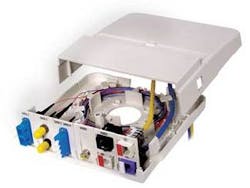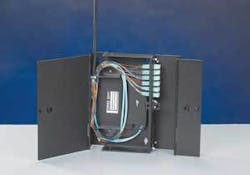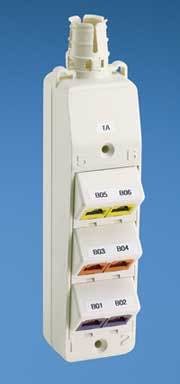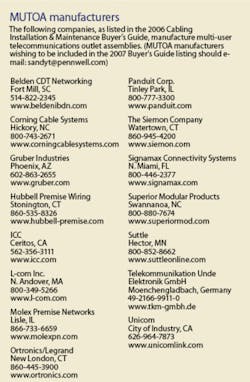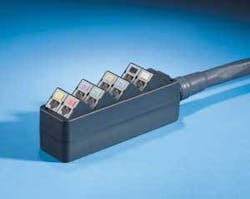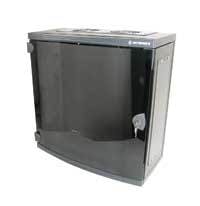The tried and true multi-user telecommunications outlet assembly is helping to combat combustible loading associated with added copper cabling in the open office and TR.
O pen office cabling and zone cabling methods have been among the most significant installation trends to spotlight the benefits of using a multi-user telecommunications outlet assembly (MUTOA) as an intermediate point in the horizontal cabling run for efficiently connecting multiple workstations.
Hubbell Premise Wiring's Advanced Multimedia Outlet (AMO) is capable of supporting up to 12 fiber and/or copper connectors, or 24 small-form-factor connectors, and is compatible with Category 6A copper.
Specifically, “When compared to traditional ‘home run’ cabling, a zone cabling approach makes it quicker and easier to manage MACs because shorter cable runs are used to connect zone boxes to local work areas,” explains Brett Swett, business development manager for Panduit’s zone cabling solutions (see “Another look at zone cabling,” Cabling Installation & Maintenance, July 2005, page 20).
While MUTOA technology has not changed significantly in recent years, it’s no longer confined to helping overcome ‘home run’ cable management issues. In fact, the MUTOA is now seen by some manufacturers as a sort of fire extinguisher.
It’s hot up there
“The growth in combustible loading associated with the installation of high numbers of low-pair-count cables wired in a home run configuration between individual users and a horizontal wiring closet is a growing concern,” warns Don Hall, senior applications engineer at Corning Cable Systems.
Removal of abandoned cable from building pathways and concealed spaces is now a requirement of NFPA 70 of The National Electrical Code, with additional Code proposals being considered during the 2008 revision cycle. “While recent Code proposals have centered upon the specification of cables having lower heat of combustion,” Hall says, “an opportunity exists to eliminate the home run architecture by use of a fiber MUTOA and high-fiber-count cable.”
Accordingly, Corning Cable Systems says its wall-mountable interconnect center can be installed in the open office environment as a MUTOA to help combat large volume cable combustion concerns. “Placement of a fiber MUTOA in a work area close to a group of LAN users enables a large reduction of combustible loading on a ‘per user’ basis,” Hall says, “because numerous low-pair-count [copper] cables are replaced by a single high-fiber-count distribution cable. This benefit derives from the inherent immunity of fiber to all forms of crosstalk, resulting in the ability to place high numbers of fibers within a single cable.”
Corning Cable Systems’ studies indicate that a consolidated fiber to MUTOA solution for 12 workstation users will provide a total combustible load “fuel” reduction of 69% compared to a typical Category 5e homerun installation to the wiring closet.
The company’s WIC-02P (pictured below) has a fiber termination capacity of up to 24 fibers (12 users) when SC duplex connectors are used, and up to 48 fibers (24 users) when small-form-factor LC duplex connectors are used. Security features include optional door lock, subscriber jumper protection door on the front, and panels with keyed and color-coded LC adapters.
Versatility matters
Another fiber-to-MUTOA solution that is also copper-friendly, the Advanced Multimedia Outlet (AMO) from Hubbell Premise Wiring, is capable of supporting up to 12 fiber and/or copper connectors, or 24 small-form-factor connectors.
“The low-profile AMO may be used as a MUTOAas specified in ANSI/TIA/EIA-568-B.1, is compatible with [Hubbell’s] MediaTrak raceway, and also accommodates Category 6A,” notes Hubbell’s marketing communications manager, Janet Crook. The AMO (pictured, page 80) provides fiber storage supporting up to 1 meter of buffered fiber, and features a cable-routing drum plus a MUTOA labeling field hidden beneath the cover.
Panduit’s MUTOA Six-Position Outlet Box (pictured, above) is designed to meet more sweeping technology and installation trends, including open office environments, the need for network connection flexibility/portability and easy deployment, versatile mounting options-magnet, adhesive, screw-down, or suspended-to meet a range of installations, and larger cable diameters.
Featuring mounting eyelets so that the MUTOA can be suspended from wall, ceiling, under desk, or under raised floor, the outlet box includes a cable tie support slot that helps secure cables in place during installation.
Panduit's MUTOA Six-Position Outlet Box for open office and other installations features mounting eyelets so that it can be suspended from wall, ceiling, under desk, or under raised floor.
“[The box’s] compact design makes it easy to move or reposition, and it can be used in conjunction with pre-assembled cables that have been previously factory tested, for a faster, more economical and reliable installation,” says Marisa Mrozinski, Panduit business development manager for outlets.
An expandable cable entry is designed to accommodate larger cable diameters. “You can adjust the opening from .695-inch to .825-inch. Smaller diameter cables can be used as well, due to the bend radius control feature,” adds Mrozinski.
New pathways for MUTOAs
Responding to recently approved telecom enclosure standards that are seen as supporting increased use of MUTOAs in the telecom room, Ortronics/Legrand plans to introduce a Telecommunications Enclosure in the first quarter of 2007 (pictured at right) designed to incorporate the company’s existing MUTOA solutions, such as Clarity 6 and 5E 12-port mini patch panels and Jak-Paks, and the MUTOA Mac-Pak.
“TIA/EIA-569-B Pathways and Spaces, which defines a telecom enclosure (TE) ‘space,’ and TIA/EIA-568-B.1 Addendum 5, which defines the TE cabling to and from that space, as well as an increase in bandwidth-intensive applications, such as 10-Gbit Ethernet and VoIP, support an increased use of MUTOAs,” says Lars Larsen, Ortronics/Legrand product manager/physical support products.
Telecommunications Enclosure implementations will allow the backbone cabling to pass through directly to the TE, eliminating the need for most telecom rooms on each floor, reducing the size of telecom rooms, or allowing greater flexibility for adding capabilities to the network without having to disturb existing TRs.
“In many cases,” says Larsen, “a fiber backbone is used. From the TE, it is then very easy to bring cables to a MUTOA, allowing greater flexibility to provide work groups with high bandwidth connections, without having to re-cable existing workstation outlets that can still be used for voice and standard data connections.”
Ortronics/Legrand’s Telecommunications Enclosure, to be available in wall-, ceiling- or floor-mount designs, will include a brush cable exit to prevent debris from entering, and is designed to simplify rearrangement of exiting cable when accommodating MACs. The enclosure will also have swing-out access, advanced cable management capabilities, and offer provision for conduit, metal or plastic raceway, and cooling fans.STEVE SMITH is executive editor for Cabling Installation & Maintenance.
